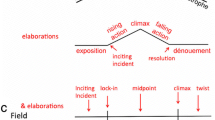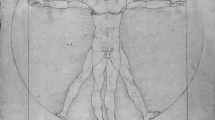Abstract
What about the connection between ›narrative diagrammatics‹ and real ›graphical diagrams‹? To find the link between diagrammatics and diagrams, we have to interpret both as phenomena of surfaces. To be able to reflect on diagrams and their operative potential, what matters is not only their visibility, but the two-dimensional spatiality. Texts and diagrams use artificial flatness as a medium of depiction and inscription. The essay conceptualizes a ›grammar of the diagrammatics‹ by outlining different attributes like materiality, flatness, directionality, graphism, relationality, reference, normativity, operativity, mediality. No single feature is sufficient for specifying what it is to be a diagram, but their interdependence delineates the conceptual field of diagrams. One of the most relevant effects of diagrams is the possibility to present time by spatial relations. Is this ›spatialization of time‹ the crucial point to connect narrative diagrammatics to graphical diagrams?
Similar content being viewed by others
Literatur
Bauer, Matthias/ Ernst, Christoph: Diagrammatik. Einführung in ein kultur- und medienwissenschaftliches Forschungsfeld. Bielefeld 2010.
Bogen, Steffen: »Schattenriss und Sonnenuhr. Überlegungen zu einer kunsthistorischen Diagrammatik«. In: Zeitschrift für Kunstgeschichte 68 (2005), S. 153–176.
Cancik-Kirschbaum, Eva/ Mahr, Bernd: »Anordnung und ästhetisches Profil. Die Herausbildung einer universellen Kulturtechnik in der Frühgeschichte der Schrift«. In: Horst Bredekamp/ Gabriele Werner (Hg.): Diagramme und bildtextile Ordnungen. Berlin 2005, S. 97–114.
Ehlich, Konrad: »Schrifträume«. In: Krämer / Cancik-Kirschbaum / Totzke 2012, S. 39–60.
Giaquinto, Marcus: Visual Thinking in Mathematics. An epistemological study. Oxford 2007.
Greber, Erika/ Ehlich, Konrad/ Müller, Jan-Dirk (Hg.): Materialität und Medialität von Schrift. Bielefeld 2002.
Grube, Gernot/ Kogge, Werner/ Krämer, Sybille (Hg.): Schrift. Kulturtechnik zwischen Auge, Hand und Maschine. München 2005.
Hamilton, Kelly: »Wittgenstein and the Mind’s Eye«. In: James C. Klagge (Hg.): Wittgenstein. Biography and Philosophy. Cambridge 2001, S. 53–95.
Hankins, Thomas L./ Silverman, Robert J.: Instruments and the Imagination. 2. Aufl. Princeton 1999.
Hankins, Thomas L.: »Blood, Dirt, and Nomograms: A Particular History of Graphs«. In: ISIS 90 (1999), S. 50–80.
Harris, Roy: The Origins of Writing. London 1986.
Kiening, Christian/ Stercken, Martina (Hg.): SchriftRäume. Dimensionen von Schrift zwischen Mittelalter und Moderne. Zürich 2008.
Kogge, Werner: »Erschriebene Denkräume: Die Kulturtechnik Schrift in der Perspektive einer Philosophie der Praxis«. In: Grube / Kogge / Krämer 2005, S. 137–169.
Krämer, Sybille: »Sprache und Schrift oder: Ist Schrift verschriftete Sprache«. In: Zeitschrift für Sprachwissenschaft 15 (1996), S. 92–112.
Krämer, Sybille: »›Schriftbildlichkeit‹ oder: Über eine (fast) vergessene Dimension der Schrift«. In: Dies./Horst Bredekamp (Hg.): Bild, Schrift, Zahl. München 2003, S. 157–176.
Krämer, Sybille: Medium, Bote, Übertragung. Kleine Metaphysik der Medialität. Frankfurt a. M. 2008.
Krämer, Sybille: »Übertragen als Transformation oder: Wie ist die Kreativität von Medien erklärbar?«. In: Medienphilosophie. Zeitschrift für Medien- und Kulturforschung 2 (2010), S. 77–93.
Krämer, Sybille/ Giertler, Mareike (Hg.): »Schwerpunkt ›Schriftbildlichkeit‹«. In: Sprache und Literatur 107, 1 (2011), S. 1–5.
Krämer, Sybille: »Punkt, Strich, Fläche. Von der Schriftbildlichkeit zur Diagrammatik«. In: Krämer / Cancik-Kirschbaum / Totzke 2012, S. 79–100.
Krämer, Sybille/ Cancik-Kirschbaum, Eva/ Totzke, Rainer (Hg.): Schriftbildlichkeit. Wahrnehmbarkeit, Materialität und Operativität von Notationen. Berlin 2012.
Krämer, Sybille: »Gedanken sichtbar machen. Platon: Eine diagrammatologische Rekonstruktion. Ein Essay«. In: Jan-Henrik Möller/ Jörg Sternagel/ Lenore Hipper (Hg.): Paradoxalität des Medialen. München 2013, S. 175–192.
Lambert, Johann Heinrich: »Theorie der Zuverläßigkeit der Beobachtungen und Versuche«. In: Ders.: Beyträge zum Gebrauche der Mathematik und deren Anwendung. Berlin 1765, S. 424–488.
Latour, Bruno: »Visualization and Cognition. Thinking with Eyes and Hands«. In: Henrika Kuklick (Ed.): Knowledge and Society. Studies in the Sociology of Culture Past and Present. Greenwich 1986, S. 1–40.
Lüthy, Christoph: »Where Logical Necessity Becomes Visual Persuasion: Descartes’ clear and distinct illustrations«. In: Sachiko Kusukawa/ Ian Maclean (Hg.): Transmitting Knowledge. Words, Images, and Instruments in Early Modern Europe. Oxford 2006, S. 97–133.
Lüthy, Christoph/ Smets, Alexis: »Words, Lines, Diagrams, Images: Towards a History of Scientific Imagery«. In: Early Science and Medicine 14 (2009), S. 398–439.
Mersch, Dieter: »Die Geburt der Mathematik aus der Struktur der Schrift«. In: Grube / Kogge / Krämer 2005, S. 211–236.
Mersch, Dieter: »Wittgensteins Bilddenken«. In: Deutsche Zeitschrift für Philosophie 54 (2006), S. 925–942.
Meyer-Krahmer, Benjamin: »My Brain is Located in my Inkstand–The Graphic Practice of Charles S. Peirce«. In: Krämer / Cancik-Kirschbaum / Totzke 2012, S. 401–414.
Netz, Reviel: »Greek Mathematical Diagrams: Their Use and Their Meaning«. In: For the learning of Mathematics 18, 3 (1998), S. 33–39.
Philip, James A.: »Platonic Diairesis«. In: Transactions and Proceedings of the American Philological Association 97 (1966), S. 335–358.
Reichert, André: Diagrammatik des Denkens. Descartes und Deleuze. Bielefeld 2013.
Ricoeur, Paul: Zeit und Erzählung. Bd. 1: Zeit und historische Erzählung. München 1988.
Ross, David William: Plato’s Theory of Ideas. Oxford 1951.
Stekeler-Weithofer, Pirmin: »Die soziale Logik der Anschauung«. In: Joachim Bromand/ Guido Kreis (Hg.): Was sich nicht sagen lässt. Das Nicht-Begriffliche in Wissenschaft, Kunst und Religion. Festschrift für Wolfgang Hogrebe. Berlin 2010, S. 235–256.
Stenning, Keith/ Lemon, Oliver: »Aligning Logical and Psychological Perspectives on Diagrammatic Reasoning«. In: Artificial Intelligence Review 15 (2001), S. 29–62.
Stetter, Christian: Schrift und Sprache. Frankfurt a. M. 1997.
Stjernfelt, Frederic: »Diagrams as Centerpiece of a Peircian Epistemology«. In: Transactions of the Charles S. Peirce Society 36 (2000), S. 357–384.
Stjernfelt, Frederic: Diagrammatology. An Investigation on the Borderlines of Phenomenology, Ontology and Semiotics. Dordrecht 2007.
Summers, David: Real Spaces: World Art History and The Rise of Western Modernism. New York 2003.
Witte, Georg: »Textflächen und Flächentexte. Das Schriftsehen in der literarischen Avantgarden«. In: Grube / Kogge / Krämer 2005, S. 375–399.
Wittgenstein, Ludwig: Philosophische Untersuchungen. Frankfurt a. M. 1984.
Wöpking, Jan: Raum und Erkenntnis. Elemente einer Theorie epistemischen Diagrammgebrauchs. Inaugural-Dissertation. FU Berlin 2012.
Zittel, Claus: Theatrum philosophicum. Descartes und die Rolle ästhetischer Formen in der Wissenschaft. Berlin 2009.
Author information
Authors and Affiliations
Corresponding author
Rights and permissions
About this article
Cite this article
Krämer, S. Zur Grammatik der Diagrammatik. Z Literaturwiss Linguistik 44, 11–30 (2014). https://doi.org/10.1007/BF03379712
Published:
Issue Date:
DOI: https://doi.org/10.1007/BF03379712




